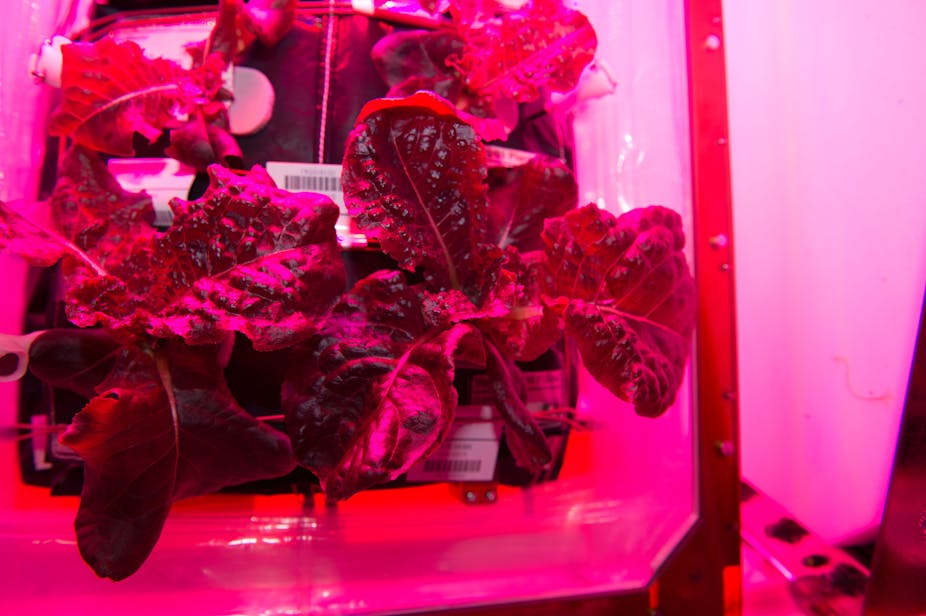For the first time, astronauts on board the International Space Station (ISS) have enjoyed munching down on food they have grown themselves. That’s a really special achievement considering the three things required for growing food – soil, water and sunlight – are in short supply when orbiting 400km above the Earth.
Following in the footsteps of many first-time veggie-growers, the first harvested meal on the ISS was a simple lettuce – a red romaine lettuce “Outredgous” that was chosen because it is hardy, compact and nutritious. After ‘washing’ the lettuce with sanitised wipes, the astronauts first tried their salad plain, then added a little olive oil and balsamic vinegar to bring out the flavour.
Having fresh food on the ISS is a treat. When supply ships arrive on the station, they generally carry a limited quality of fresh fruits and vegetables, such as apples and carrots. These perishable treats must be eaten quickly.
But, this is something more. Anyone who has ever grown their own food, will also know the joy of things tasting better when you’ve been the one tending the garden.
How does your garden grow?
In space, astronauts use aeroponics to grow their garden. The plants are grown mostly in air, with just a very small amount of nutrient rich water. Sunlight is provided by a bank of red, blue and green LED lights. The plants actually gain enough energy to grow from the red and blue lights alone. But this makes the lettuce a weird purple colour. Green LED lights, which are less efficient, were added to make the lettuce more attractive to eat. (It’s a little known fact that sunlight peaks in green light).

The gardening system was developed and tested on the ground by Orbital Technologies Corporation (ORBITEC). The system was then flown up to the ISS on a SpaceX resupply mission in April 2014. It also included three sets of seed pillows: two containing lettuce seeds and one with zinnia flower seeds.
The first set of lettuce seeds were successfully grown in May 2014. But after harvesting, the plants were frozen and returned to Earth that October. Since the plants are grown in the open air of the ISS there was a need to test them for any microbes and ensure that such food would be safe for the astronauts to eat.
Having passed the food safety analysis, the second crop of lettuce, grown last month, could be added to the astronauts’ menu. However, even then only half could be eaten, the other was set aside to return to Earth for analysis.
Space Gardening
One of the obvious outcomes of being able to eat food grown in space is the potential to be self-sufficient on long space journeys, such as a trip to Mars. But NASA scientists are also looking into the important psychological benefits of tending a garden in space.
Looking after a garden provides meaningful daily work and it’s also a way to de-stress and unwind. Personally, I’m not a great gardener, but I still fondly remember the amazing veggie-patch that took up most of the backyard of the first share-house I ever lived in. At that time I was studying for my PhD and tending to that garden was a great escape from the intense work. And there was a simple joy in eating what we grew.
Imagine how important a space-garden could become and the value and impact it would have on a long-duration space voyage. There’s also the delight of having something green and growing – a little piece of Earth – when not only are you far from home but also so removed from nature.
“There’s nothing like the smell of living green in this forest of engineered machinery,” the American astronaut Don Pettit wrote in an update to his blog Diary of a Space Zucchini.
Back in 2012, Pettit grew his own vegetables as a fun personal science project during a five-month stint on the ISS. Using zip-lock bags Pettit successfully grew a sunflower, broccoli and zucchini. These vegetables would not end up on the dinner table. Instead, Zucchini became a valued crew member and even had his own blog.

“I noticed that Sunflower and Broccoli are still with us and we are all part of the crew,” he updated in March 2012.
“We may be leafless stalks but are sprouting new tiny leaf-buds. They are a vibrant green and brought a smile to Gardener’s face. Did I notice a small bit of water in the corner of his eyes?”

To the astronauts, as they gathered around for lunch on Monday this week, it may have been just a tiny bit of home-grown salad to brighten the day. But in the broader context, that small lettuce leaf is a symbol of potentially great things to come. Perhaps one day, there will be fresh food to nourish space-faring astronauts and the job of growing that food to nurture their well-being.

